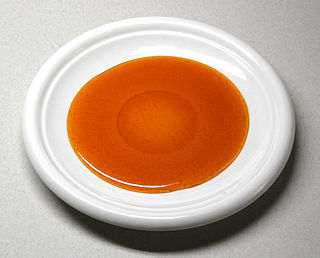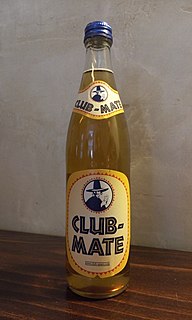Awards
In trials, the Beverage Tasting Institute of the USA awarded DOT AU Vodka the gold medal, declaring the vodka as "Exceptional". They reviewed the product as "Clear, mild tarragon, lemon verbena, and white pepper aromas. A smooth, silky entry leads to a glycerous, dry-yet-fruity medium body of candied lime zest, cream, tarragon, and green peppercorns. Finishes with a long spicy sweet fade of verbena and powdered sugar. Very appealing, delicate, and elegant citrus and herb flavors with a great texture. Serve in martinis or gimlets."

Vodka is a clear distilled alcoholic beverage. Different varieties originated in Poland, Russia, and Sweden. Vodka is composed mainly of water and ethanol but sometimes with traces of impurities and flavourings. Traditionally, it is made by distilling liquid from fermented cereal grains, and potatoes since introduced in Europe in the 1700's. Some modern brands use fruits, honey, or maple sap as the base.

Caramel is an orange-brown confectionery product made by heating a range of sugars. It can be used as a flavoring in puddings and desserts, as a filling in bonbons, or as a topping for ice cream and custard.

Mulled wine, also known as spiced wine, is an alcoholic drink usually made with red wine, along with various mulling spices and sometimes raisins, served hot or warm. It is a traditional drink during winter, especially around Christmas. It is usually served at Christmas markets in Europe, primarily in Germany. There are non-alcoholic versions of it. Vodka-spiked mulled wine can be found in Polish Christmas markets, where mulled wine is commonly used as a mixer.

Smirnoff is a brand of vodka owned and produced by the British company Diageo. The Smirnoff brand began with a vodka distillery founded in Moscow by Pyotr Arsenievich Smirnov (1831–1898). It is distributed in 130 countries. Smirnoff products include vodka, flavoured vodka, and malt beverages. In 2014, Smirnoff was the best selling vodka around the world.

Cream soda is a sweet soft drink. Generally flavored with vanilla and based on the taste of an Ice cream float, a wide range of variations can be found worldwide.
Grey Goose is a brand of vodka produced in France. It was created in the 1990s by Sidney Frank, who sold it to Bacardi in 2004. The Maître de Chai for Grey Goose is François Thibault, who developed the original recipe for the vodka in Cognac, France.
Karsk is a Swedish and Norwegian cocktail containing coffee together with moonshine and sometimes a spoon of sugar. Broader, it can also be found in other parts of Scandinavia.

Limeade is a lime-flavored drink sweetened with sugar. A typical method of preparation is to juice limes, and combine the juice with simple syrup or honey syrup, along with some additional water and perhaps more sugar or honey. Vodka or white tequila can be added to make a limeade cocktail.

Krupnik or Krupnikas (Lithuanian) is a traditional sweet alcoholic drink similar to a liqueur, based on grain spirit and honey, popular in Poland, Belarus and Lithuania. In Poland it is grouped in the nalewka category of alcoholic beverages. Mass-produced versions of krupnik consist of 40–50% alcohol, but traditional versions will use 80–100% grain alcohol as the base. Honey, usually clover honey, is the main ingredient used to add sweetness, as well as up to 50 different herbs. There are many versions and some recipes have been passed down through generations; producers typically uses their own recipes.

A liqueur coffee is a caffeinated alcoholic drink that consists of a shot of liqueur, mixed with coffee. It is typically served in a liqueur glass, often accompanied with cream and sugar. Coffee liqueur beverages are served in different fashions and can be found throughout many countries. One of the most popular liqueur coffee beverage is commonly known as Irish coffee. Liqueur coffee beverages are largely classified as cocktails as well as digestifs which are aimed at aiding the digestive process typically after a meal.

Nalewka, plural nalewki, is a traditional alcoholic beverage from Poland. Similar to medicinal tinctures, it is usually 40% to 45% alcohol by volume, though some can be as strong as 75%. Nalewka is created by macerating and / or infusing various ingredients in alcohol, usually vodka or neutral spirits. Among the ingredients often used are fruits, herbs, spices, roots, sugar and honey. The name nalewka is currently being registered for national appellation within the European Union. Unlike ordinary liqueurs, nalewki are usually aged. Since nalewka is produced by infusion rather than distillation, the liquid is typically colorful and somewhat opaque. Taste-wise, nalewka is similar to fruit liqueurs such as schnapps or eau-de-vie, but is usually sweeter and typically lacks a strong alcohol taste.
Vișinată is a Romanian alcoholic beverage produced from sour cherries, sugar and alcohol. It is very flavorful and sweet, and most often home-made. As a consequence, there is no "official" recipe for it. Everybody tunes quantities and preparation methods to suit their own taste.
Jean-Marc XO Vodka is a vodka distilled in the Cognac region of France by Jean-Marc Daucourt and owned by the Campari Group.

A flaming drink is a cocktail or other mixed drink that contains flammable, high-proof alcohol, which is ignited before consumption. The alcohol may be an integral part of the drink, or it may be floated as a thin layer across the top of the drink. The flames are mostly for dramatic flair. However, in combination with certain ingredients, the flavor of the drink is altered. Some flavors are enhanced, and the process may impart a toasted flavor to some drinks.

A greyhound is a cocktail consisting of grapefruit juice and gin mixed and served over ice. If the rim of the glass has been salted, the drink is instead called a salty dog.
Azerbaijani cuisine refers to the cooking styles and dishes of the Republic of Azerbaijan. The cuisine developed significantly due to its diversity of agriculture, from abundant grasslands which historically allowed for a culture of pastoralism to develop, as well as to the unique geographical location of Azerbaijan, which is situated on the crossroads of Europe and Asia with an access to the Caspian Sea. The location has enabled the people to develop a varied diet rich in produce, milk products, and meat, including beef, mutton, fish and game. The location, which was contended over by many historical kingdoms, khanates, and empires, also meant that Azerbaijani cuisine was influenced by the culinary traditions of multiple different cultures, such as Turkic, Iranian, and Eastern European.

Club-Mate is a caffeinated carbonated mate-extract beverage made by the Loscher Brewery near Münchsteinach, Germany, which originated in 1924. Club-Mate has 200 mg of caffeine per litre. Club-Mate has a relatively low sugar content of 50 g per litre, and low calories compared to other beverages such as cola or most energy drinks.
AnestasiA Vodka is a vodka distilled in the United States. The spelling comes from the founder's family name and the bottle's shape represents the letter A for AnestasiA and the letter V for vodka.












